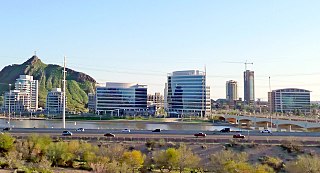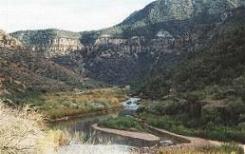
Maricopa County is located in the south-central part of the U.S. state of Arizona. The U.S. Census Bureau estimated its population was 4,485,414 as of 2019, making it the state's most populous county, and the fourth-most populous in the United States, containing more than half the population of Arizona. It is more populous than 23 states. The county seat is Phoenix, the state capital and fifth-most populous city in the United States.

Scottsdale is a city in the eastern part of Maricopa County, Arizona, United States, part of the Greater Phoenix Area. Named Scottsdale in 1894 after its founder Winfield Scott, a retired U.S. Army chaplain, the city was incorporated in 1951 with a population of 2,000. The 2019 population of the city was estimated to be 258,069 according to the U.S. Census Bureau. The New York Times described downtown Scottsdale as "a desert version of Miami's South Beach" and as having "plenty of late night partying and a buzzing hotel scene." Its slogan is "The West's Most Western Town."

Tempe, is a city in Maricopa County, Arizona, United States, with the Census Bureau reporting a 2019 population of 195,805. The city is named after the Vale of Tempe in Greece. Tempe is located in the East Valley section of metropolitan Phoenix; it is bordered by Phoenix and Guadalupe on the west, Scottsdale and the Salt River Pima–Maricopa Indian Community on the north, Chandler on the south, and Mesa on the east. Tempe is also the location of the main campus of Arizona State University.

The Salt River is a river in Gila and Maricopa counties in Arizona, United States, that is the largest tributary of the Gila River. The river is about 200 miles (320 km) long. Its drainage basin is about 13,700 square miles (35,000 km2) large. The longest of the Salt River's many tributaries is the 195-mile (314 km) Verde River. The Salt's headwaters tributaries, the Black River and East Fork, increase the river's total length to about 300 miles (480 km). The name Salt River comes from the fact that the river flows over large salt deposits shortly after the merging of the White and Black Rivers.

The Phoenix Metropolitan Area – also the Valley of the Sun, the Salt River Valley, or Phoenix Metro – is a metropolitan area, centered on the city of Phoenix, that includes much of the central part of the U.S. state of Arizona. The United States Office of Management and Budget designates the area as the Phoenix-Mesa-Scottsdale Metropolitan Statistical Area (MSA), defining it as Maricopa and Pinal counties. As of the Census Bureau's 2017 population estimates, Metro Phoenix had 4,737,270 residents, making it the 10th largest Metropolitan Area in the nation by population. The gross domestic product of the Phoenix Metropolitan Area was $242 billion in 2017, 16th largest amongst metro areas in the United States.

Arizona State Route 101 is a semi-beltway encompassing much of the Phoenix Metropolitan Area in the United States. It connects several suburbs of Phoenix, including Tolleson, Glendale, Peoria, Scottsdale, Mesa, Tempe, and Chandler. Construction began in the late-1980s and was completed in 2001. Additional general purpose lanes and a high occupancy vehicle lane (HOV) are being constructed along the eastern stretch of Loop 101 from Scottsdale to Chandler, starting at Princess Drive to Loop 202.
State Route 202 or Loop 202 is a partial beltway looping around the eastern areas of the Phoenix metropolitan area in central Arizona. It traverses the eastern end of the city of Phoenix, in addition to the cities of Tempe, Mesa, Chandler, and Gilbert, and is a vital route in the metropolitan area freeway system. Loop 202 has three officially designated sections along its route; the Red Mountain Freeway, the SanTan Freeway, and the South Mountain Freeway, also known as the Ed Pastor Freeway. The Red Mountain Freeway runs from the Mini Stack Interchange with Interstate 10 (I-10) and State Route 51 (SR 51) in Phoenix to the SuperRedTan Interchange with U.S. Route 60 in Mesa. The SanTan Freeway runs from there to an interchange with Interstate 10 (I-10) in Chandler. The South Mountain Freeway, officially known as the Congressman Ed Pastor Freeway, runs from there to Interstate (I-10) in western Phoenix.

The Roman Catholic Diocese of Phoenix in Arizona is a particular church of the Roman Catholic Church in the United States. It was established on December 2, 1969 when it was split off from the Diocese of Tucson. Its ecclesiastic territory includes Maricopa, Mohave, Yavapai, and Coconino counties, and also includes the Gila River Indian Reservation in Pinal County. The bishop is Thomas Olmsted.
The East Valley Tribune is a Pulitzer Prize winning newspaper concentrated on cities within the East Valley region of metropolitan Phoenix, including Mesa, Tempe, Chandler, Gilbert and Queen Creek.

The Salt River Pima–Maricopa Indian Community comprises two distinct Native American tribes—the Pima and the Maricopa (Piipaash)—many of whom were originally of the Halchidhoma (Xalchidom) tribe. The community was officially created by an Executive Order of US President Rutherford B. Hayes on June 14, 1879. The community area includes 53,600 acres (217 km2), of which 19,000 remain a natural preserve. The community is a federally recognized tribe located in Arizona.

Maricopa Association of Governments (MAG) is a Council of Governments (COG) that serves as the regional agency for the greater Maricopa region in Arizona, USA. This includes the Phoenix area and the neighboring urbanized area in Pinal County, containing the Town of Florence and City of Maricopa. When MAG was formed in 1967, the elected officials recognized the need for long-range planning and policy development on a regional scale. They realized that many issues such as transportation, air quality and human services affected residents beyond the borders of their individual jurisdictions.
The metropolitan area of Phoenix in the U.S. state of Arizona contains one of the nation's largest and fastest-growing freeway systems, boasting over 1,405 lane miles (2,261 km) as of 2005.
Many arterial roads in the Phoenix metropolitan area have the same name in multiple cities or towns. Some roads change names or route numbers across town borders, resulting in occasional confusion. For example, the road known as Apache Boulevard in Tempe continues east as Main Street in neighboring Mesa and then as Apache Trail in Apache Junction. Although Broadway Road maintains the same name through Goodyear, Avondale, Phoenix, Tempe, Mesa, and Apache Junction, each town uses a different reference point for address numbers.
The East Valley is a multi-city region within the Phoenix metropolitan area of Arizona.
There is a current proposal to bring commuter rail service to the Phoenix, Arizona metropolitan area.








